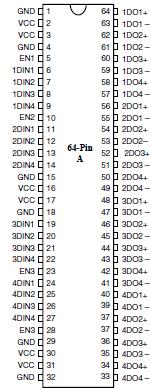Features: • Sixteen line drivers meet or exceed the requirements of theANSI EIA/TIA-644 Standard
• Designed for signaling rates up to 500 Mbps with very lowradiation (EMI)
• Low voltage differential signaling with typical output voltageof 350mV into : 100 load (PI90LV387) 50 load (PI90LVB387)
• Propagation delay times less than 2.6ns
• Output skew is less than 150ps
• Part-to-part skew is less than 1.5ns
• 35mW total power dissipation in each driver operating at 200MHz
• Bus-pin ESD protection exceeds 10kV
• Low voltage TTL (LVTTL) logic inputs are 5V tolerant
• Packaging (Pb-free & Green available):-64-Pin TSSOP (A)Pinout Specifications
SpecificationsSupply Voltage Range, VCC
(2)........................................ 0.5V to 4V
Voltage Range: Inputs ............................................ 0.5V to 6V
DO+ or DO............................................................. 0.5V to 4V
Electrostatic Discharge(3):
(DO+,DO and GND).......................Class 3, A: 10kV, B:700V
(All Pins) ..........................................Class 3, A: 8kV, B:600V
Continuous Power Dissipation......(see dissipation rating table)
Storage Temperature Range ............................. 65°C to 150°C
Lead Temperature 1.6mm (1/16 inch)
from case for 10 seconds...............................................260°C
Notes:
1. Stresses beyond those listed under "Absolute Maximum Ratings"may cause permanent damage to the device. These are stress ratingsonly, and functional operation of the device at these or any otherconditions beyond those indicated under "Recommended OperatingConditions" is not implied. Exposure to Absolute-Maximum-Ratedconditions for extended periods may affect device reliability.
2. All voltage values, except differential I/O bus voltages, are withrespect to ground terminal.
3. Tested in accordance with MIL-STD-883C Method 3015.7
DescriptionPI90LV387/ PI90LVB387 consists of sixteen differential linedrivers that implement the electrical characteristics of low-voltagedifferential signaling (LVDS). This signaling technique lowersoutput voltage levels to reduce power, increase switching speeds,and allow operation with a 3V supply rail.
The intended application of PI90LV387/ PI90LVB387 and signaling techniqueis for point-to-point baseband (single termination) and multipoint(double termination) data transmission over a controlledimpedance media of approximately 100 and 50 (LVB387).
The transmission media may be printed-circuit board traces, backplanes,or cables. The large number of drivers integrated into thesame substrate, with the low pulse skew of balanced signaling,allows extremely precise timing alignment of clock and data forsynchronous parallel data transfers. When used with its companion16-channel receivers, the PI90LV386 or PI90LVT386, over 400million data transfers per second in single-edge clocked systemsare possible with very little power.
(Note: The ultimate rate and distance of data transfer is dependentupon attenuation characteristics of the media, the noise couplingto the environment, and other system characteristics.)The drivers are enabled in groups of five. When disabled, driveroutputs are at a high impedance. Each driver input (DIN) and enable(EN) have an internal pulldown that drives the input to a lowlevel when open circuited.
The PI90LV387/ PI90LVB387 are characterized for operation from 40°C to 85°C.

 PI90LVB387 Data Sheet
PI90LVB387 Data Sheet








